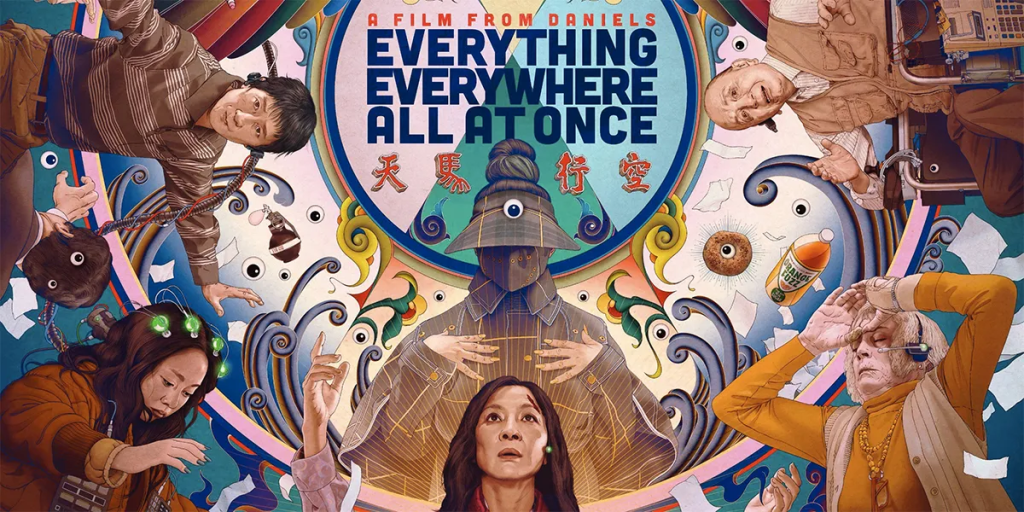
Gil Asakawa
We are in a moment. An important moment for Asian American Pacific Islander and Desi representation in American pop culture. The film “Everything Everywhere All at Once” received 11 Academy Award nominations, the most of any film, in categories including Best Picture, Best Actress, Best Supporting Actor, TWO Best Supporting Actresses, Best Director and Best Original Screenplay. It’s already won a wave of awards leading up to the Oscars.
The Internet, and especially the YouTube universe, is awash in accolades for the film. And yet, I suspect that many people who watched it were left scratching their heads and saying, “Whaaa? I don’t understand. I’m confused. What was that?”
Or, maybe that was just me.

“Everything Everywhere All At Once” is nominated for 11 Oscars. It has the chance to make Academy Awards history next month when the show airs live on March 12.
I watched it again, and this time the story line and characters, along with their many crazy variations in alternate “multiverses,” made a lot more sense. So, if it left you puzzled, watch it again. And again. It will help.
The extra effort is worth it because “EEAAO” will likely win some Oscars, maybe most, possibly all of the categories it’s nominated in. More than a few critics claim it’s the best film of 2022, and some are even calling it the best film ever.
So, what is “EEAAO” about?
It’s about Asian immigrants and their generation gap with American-born kids, about love and regret and family values. And, oh yes, it’s about the existence of multiverses – a concept from science fiction and Marvel movies in which parallel universes exist with multiple versions of all of us, with different life paths and different, well, superpowers. Yes, it helps if you’re a fan of Spiderman and Dr. Strange and Avengers movies.
It’s about a Chinese immigrant family who is suddenly tossed about in a crazy narrative of different worlds and insane characters and awesome martial arts and violence and monsters and the evil power of the Everything Bagel. Really. Although I was left dazed and confused at the end of my first viewing, I went with the flow the second time around and had a blast, like riding a roller coaster through a house of horrors.
The main characters are set in the first few minutes:
The mother is played by Michelle Yeoh, who is a grim Asian mom, strict wife and concerned businesswoman swimming through a flood of receipts and paperwork. But, she transforms and evolves throughout the plot.
Her husband, played by Ke Huy Quan, is meek and geeky, an almost childlike dad, who turns into a multiverse-traversing martial arts master.
Stephanie Hsu is perfectly cast as the daughter, whose seething anger at life leads to her being a supervillain monster in parallel multiverses.
Yeoh has been a veteran of Hong Kong and Chinese films, including her American breakout film, 2000’s “Crouching Tiger, Hidden Dragon.” In some of her many iterations through “EEAAO,” she uses her martial arts ability to great effect, but she gets the chance to show a much wider range of abilities as an actor here, including heartbreak and pure love.
If Quan looks vaguely familiar, it’s because he got his start in Hollywood with two blockbuster Steven Spielberg productions: 1984’s “Indiana Jones and the Temple of Doom” (as the perky sidekick kid Short Round) and 1985’s “Goonies” (as the nerd Data).
We never really got to see his career as he grew because after a few more years, he couldn’t even get auditions for any parts, so he went to film school and worked behind the camera for three decades. His casting, shining performance and moving life story as an Asian American actor is alone worth the ticket (or rental, or purchase) price.
He was inspired by the 2018 film “Crazy Rich Asians,” which proved a movie could be a hit with a mostly Asian cast and story line (Yeoh was a major character in that film, too).
“EEAAO” takes that success several steps further by being a financial success and critical hit while breaking a bunch of conceptual barriers and Hollywood stereotypes. It’s certainly not like any hit movie we’ve seen before.
Thanks to the visionary leadership by the writing and directing duo of “The Daniels” – Dan Kwan and Daniel Scheinert, and dizzyingly split-second editing by Paul Rogers, “EEAAO” is a thrilling funhouse experience.
Yes, it may be a blur when you watch it. But watch it again, and you’ll be rewarded and warmed by the message of the movie:
Family matters, and our community’s cultural values can hold us up even in the craziest of times, for in the end, love does conquer all.
With “Crazy Rich Asians,” 2021’s “Shang Chi and the Legend of the Ten Rings” (which, surprise, Yeoh also starred in!) and now “Everything Everywhere All at Once,” Asians are truly having a moment in American popular culture.
Let’s all enjoy the moment and support this and other movies so the moment can last into the future.
Gil Asakawa is the author of “Tabemasho! Let’s Eat! A Tasty History of Japanese Food in America” (Stone Bridge Press).



